KEF KC62
Oh my, what is that? A minuscule black cube that is heavy as a black hole and has two concentric drivers firing in opposite directions. The cube is all aluminum with only masking rims around the drivers being plastic. The cube is stylish, smooth, and looks like an aircraft engine.
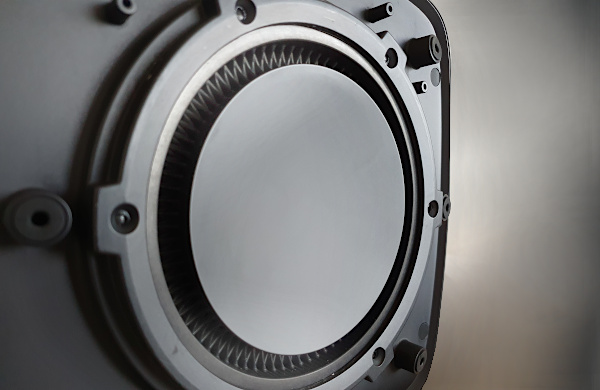
The Powershifter
Subwoofers are like fire. If you know what to do with it, it is a good servant, and you won’t be able to get around without it. If you fail to tame it, you’ll get burnt. To prevent burns, turning knobs and flipping switches on a subwoofer is not enough. It is the sub’s placement in the room that matters the most. Neither a sub nor a fire will work well in any corner of the room. Audiodrom dedicated many articles to how to properly place and dial in a subwoofer in the room, therefore I recommend checking our As we see it section of this website.
Crawling
To begin with, there are always two options: rely on measurements or on your ears. For the former, one needs a good measurement microphone and a software, as well as the ability to interpret the measurements correctly. Finding the right placement may be quite a speedy process with this technique, yet, after days and weeks you will most probably find yourself tweaking the position and the settings into something that means a departure from the “scientifically identified and great measuring” set up into a “liked by your ears and measuring less good” set up. Therefore, I recommend relying on your ears from the very start. You must like the result in the first place, no matter how it measures. You are a listener, not a loudspeaker builder, so it is rather irrelevant whether the microphone will like the sound or not. If you do, you´ve won.
This time, I let the microphone and the software be and employed the oldest of techniques: crawling. It means to place the sub in exactly the position where my head is in the listening chair, set its cross-over and volume level to reasonable pointsc, and let it play. For the playback I used my favourite pink noise, filtered into 20Hz to 200Hz. The next step was to crawl around the room, with ears at the level of where the sub drivers normally would be and listen for the spots that give you the most powerful bass. I recommend not to focus on power only, and listening for the spots with the best balance across the whole bass spectrum at the same time, as this will save you a lot of trouble later in the process. Another recommendation of mine is exploring the positions that may be counter-intuitive, like those further from the walls, or even some elevated positions. I spent 40+ minutes with this procedure, then I flipped the subwoofer’s phase and repeated the whole process once more. At the end, I had several ‘best’ spots on the floor marked with a tape. One last remark: it is usually recommended to have the main speakers disconnected during the crawling procedure. I see no reason for it, as the mains will have to blend with the sub anyway, so it is better to use right from the start all the bass drivers that are going to be a part of the puzzle later.
To move the KEF KC62 around the room is much easier than with other subs. Usually, one is limited by the length of a signal cable which connects the sub to the preamplifier. The KC62 can be connected by a speaker cable to the speaker binding posts of the amp too, which enhances the radius. On top of that, KEF offers a wireless Bluetooth protocol transmitter/receiver set (KW-1) that will help get rid of wires completely. I tested the Bluetooth set and must say it is great for the initial set-up procedure as well as for less demanding applications like home cinema. For high-end listening I can’t recommend it for this connection has around 10ms communication latency.
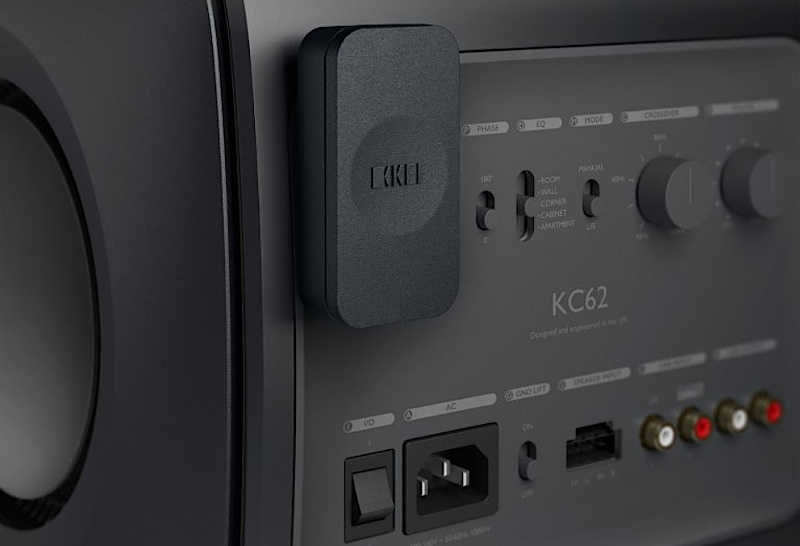
So, as said, I had six points on the floor, each marked with what was the phase and orientation of the sub. The KC62 has two opposed drivers so they can fire across, along, or diagonally in the room. This matters in the final fine-tuning if you go for the absolute precision. If you don’t, then go for what is the most convenient for you. To choose the best of all the marked positions I employed Bach’s Toccata (Cameron Carpenter, Telarc), Kraftwerk’s Tour de France, and some other bass-rich material. One by one the positions were re-evaluated for the best compromise between the power, evenness, punch, definition, and texture. It is important not to rely on recording only, and it is good to mix acoustic, electric, and synthetic bass sounds too.
Once the KC62 rested in its final location, it was time for setting the cross-over and volume. In my case it was a bit more complicated as I tried to set 2 subwoofers in the room at the same time, however the process was similar. The KEF KC62 has built-in compensation filters for a placement near room boundaries. Take it as a guidance and let – again – your ears to judge. Although my best placement was towards the front right corner, the KEF sounded the most balanced with the compensation switch at WALL position, the one that is reserved for a placement along one of the side walls. The ROOM filter was too boomy and the filter CORNER was punch-less. Some days later I used the microphone to measure how my preferences correlated with the microphone preferences. They did not. I advocate for using ears instead of software.
In my room, the subwoofer’s drivers fired in the longer dimension of the room, and by moving the sub in tiny increments along the drivers’ axis I could further optimize what I was hearing. It was a repetitive job, fortunately very rewarding at the end.
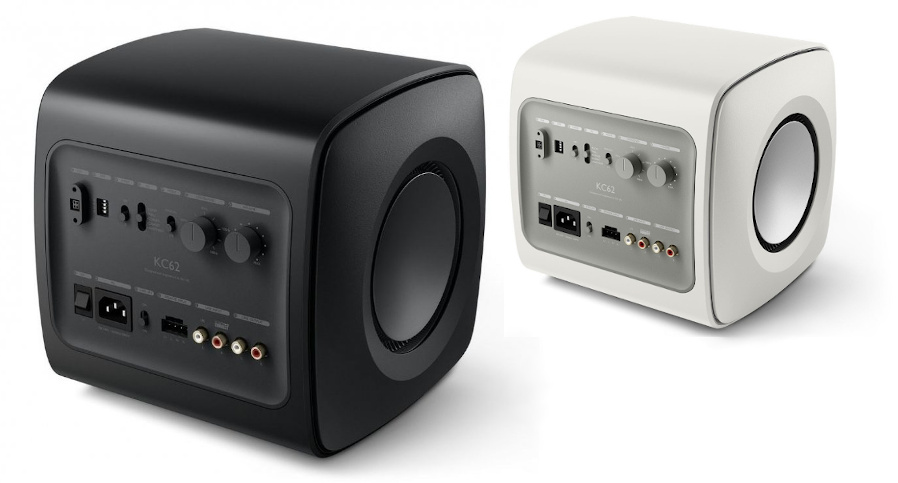
What the KEF KC62 does
The KC62 is a subwoofer and it does what you expect from a subwoofer. The point is that its contribution is comparable to much bigger subwoofers. The compact dimensions of the KC62 facilitate the placement in the locations that would be no-go for a fridge-sized sub.
The bass is what you deserve, and it is what you get. Antolini’s drums (Knock Out 2000) blasted through my room, and the kick drum had the punch and power which possibly could not be generated by a rather small box. The KC62 is a very clean subwoofer and the bass guitar was beautifully textured and deep. Japanese Kodo’s Akatsuki is a showcase of big drums and the KEF sent them to my room with roaring power, as if I was visited by a god of thunder. The plucked double-bass was pleasantly dry, its body was pleasantly three-dimensional, and its strings were strings, rather than muddy sounding ropes. The timpani in Saint-Saens’ Bacchanale (Exotic Dances from Operas) were physical and visceral, the sounds were perfectly separated, and the KEF was exceptionally fast so the monumentality was not masked by the bass overhang. The electric bass guitar from a Accuphase sampler was a bit softer and boomy to my taste so I decreased the cross-over setting by 5dB and, voila, the bass became contoured again. The KC62 provided more fidelity to a piano too, just by adding low fundamentals that were necessary to build the credible size of the instrument. As much as I loved the KEF’s contribution in the acoustic and classical music, it became indispensable in rock. Geezer Butler’s bass in Evil Woman (Black Sabbath) acquired fuller, rounder and even more menacing sound. The more complete bottom-end projected into higher octaves through its harmonics, so the electro-acoustic guitar in Raven Black Night (Gov´t Mule) showed better dynamic impact and, once again, acquired better body.
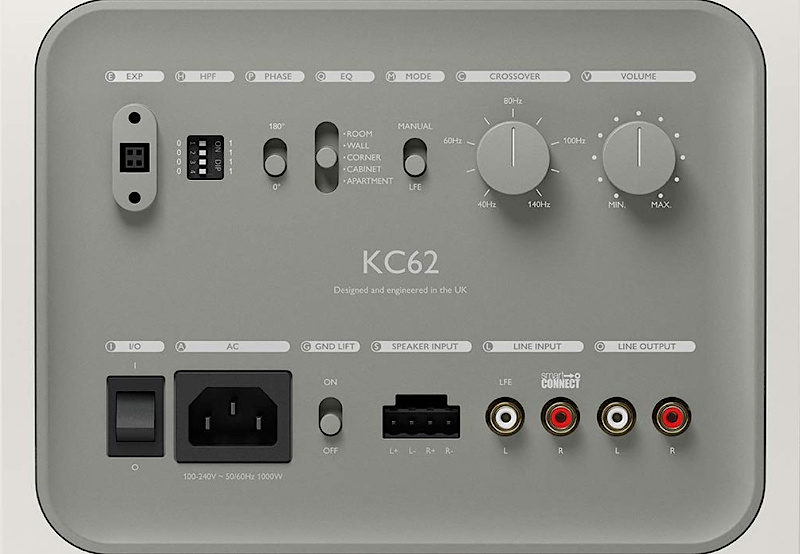
Why you should own the KC62
KEF is one of those (few) audio companies that does the real research. That is not replacing two layers of plywood with three layers of plywood or swapping cellulose cones for aluminum cones. They are serious about the technical part of their designs and pay a bit less attention to the outer shells of their speakers. I should say they were, as with the success of the KEF´s LS50 range the more life-stylish approach of KEF can be seen, of which the KC62 is a part. So, we have now a combination of the technologies inside and the attractive outer shell. The KC62 is available in beautiful carbon black finish, as well as in not less beautiful mineral white colour.
Not only did I like the small KEF KC62 – I liked it very much. I hope that KEF will implement the innovative solutions into one of the bigger subs, perhaps even with a built-in DSP. That would be a killer. Until then, the KEF KC62 is all we have and there are many reasons to buy one:
- It is compact
- It is a piece of industrial art
- Its output is really audible from 20Hz, KEF does not overstate the claim
- Its set up and dialing in are easy
Although members of some internet forums reported that they had issues to wake-up the KC62 from the stand-by mode, I did not experience a single issue. The KEF woke up swiftly, the orange control light went to white in a second, and the sub was ready to play in less than 5 seconds. So, it makes sense to send a signal to the KEF to get it ready, and only then to start the track again if you want to hear its contribution from the very first moment.
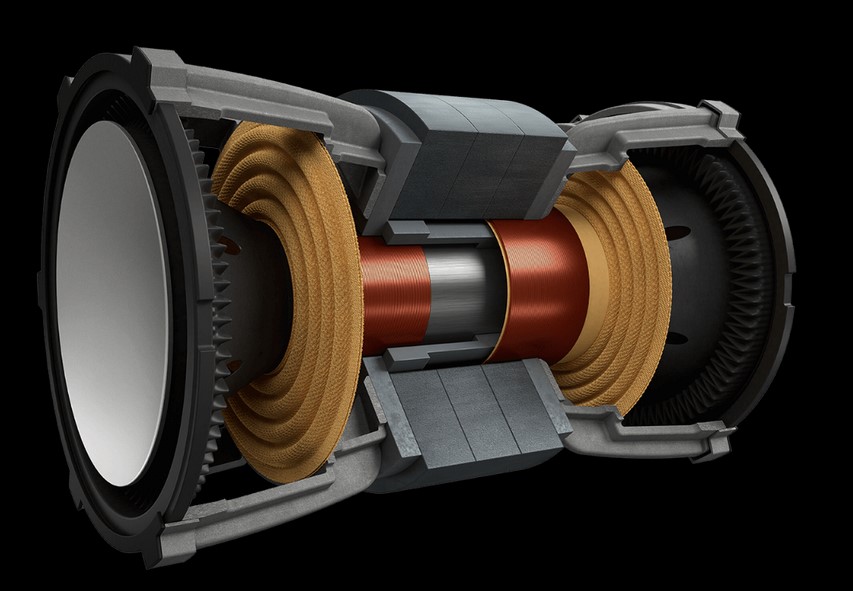
Let’s get technical
The core of the KC62 is its “Uni-Core” driver. The trick is to have two voice-coils arranged concentrically (thus each must have a different diameter), so that they both work in a force-cancelling fashion. Such a solution represents many engineering challenges, especially in the closed cabinet (there is no bass-reflex port in the KC62) and KEF has issued a complete documentation to explain its innovative approach. There has been a deep dive about the KC62 working principles and the subwoofer´s measurements published by What HiFI earlier this year, so instead of saying again what has been said already I will point you to this source. The astonishing part of the story is that in its optimum setting the KEF KC62 provides the bass output from 17Hz (-4dB), 23Hz (-2dB) respectively. These are magical performance numbers considering the sub´s modest cuboid dimensions 25x25x25cm. The bass can be reinforced by placing the KC62 near room boundaries, for which the KEF´s output can be optimized by a sliding switch. The very same switch adjusts the KC62´s output for other placements, including quiet night listening not to disturb your neighbors too much. The array of 4 small DIP switches further allows for cutting off the low frequencies below the point you set. This is variable between 40Hz and 120Hz in 5Hz increments, or you can just let it be and apply no filtering at all, using the full bottom end extension of the subwoofer. Phase is flippable between 0-180°.
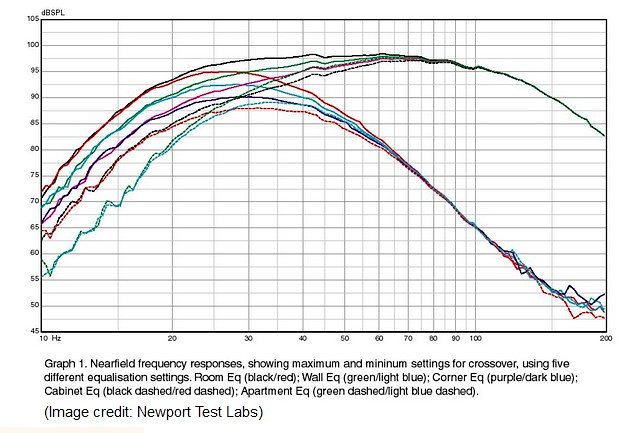
One can control the KEF by an AV receiver, or you can adjust the cross-over point to main speakers manually, with the highest frequency being 150Hz. It will depend on the main speakers that you use and bear in mind that the KC62 was designed for the KEF’s LS50 range. Should you want to pair it with full range speakers, I do recommend not crossing the sub over higher than about 60-70Hz, if you do not want to hear projection into upper bass and mids.
The KC62 does not facilitate connection via balanced (XLR) signals, it does have LFE, RCA, and speaker level inputs. For many reasons I prefer the latter, for the sub receives an identical information like the main speakers. Anyway, this must pass through the KC62’s two internal Class-D amplifiers rated 500 W each. To prevent the cones going beyond a harmonic distortion point, KEF uses SDCT Smart Distortion Control technology that monitors and regulates currents flowing through the voice coils.
Price at the time of review: 42.900,- CZK per piece
Contact: Perfect Sound Group, Praha, tel. +420 722 960 690
(C) Audiodrom 2022



